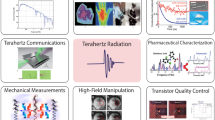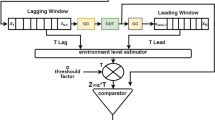Abstract
Passive bistatic radar (PBR) systems using different communication signals can only offer low-resolution target detection due to their inherent low bandwidth. In this paper, compressive sensing (CS) is applied to multichannel FM and GSM PBR to achieve improved range-Doppler resolutions and avoid some limitations of classical multiband PBR processing. In CS context, block-structured time-domain dictionary which is formed from multichannel signals suffers from coherence when fine range resolution is employed. To overcome such a pitfall, this work first transforms the dictionary to spectral domain where only the most important spectral components are retained. Principle component analysis followed by a whitening method are then applied to this spectrally transformed data in order to reduce the dimensionality of problem, thereby reducing the dictionary size and most importantly fulfilling the required condition of dictionary incoherence for better CS-based recovery. Two different block-structured dictionary formations are tested. The performance of the recovery of spatially close targets, in both FM and GSM PBR setups, are reported.






Similar content being viewed by others
References
Tabassum, M.N., Hadi, M., Alshebeili, S.: CS based processing for high resolution GSM passive bistatic radar. In: 2016 IEEE International Conference on Acoustics, Speech and Signal Processing (ICASSP), March 2016, pp. 2229–2233
Griffiths, H., Baker, C.: Passive coherent location radar systems. Part 1: performance prediction. In: IEE Proceedings Radar, Sonar and Navigation, vol. 152, no. 3. pp. 153–159. IET (2005)
Zemmari, R., Nickel, U., Wirth, W.-D.: GSM passive radar for medium range surveillance. In: European Radar Conference EuRAD, Sept. 2009, pp. 49–52 (2009)
Kuschel, H., Heckenbach, J., Muller, S., Appel, R.: On the potentials of passive, multistatic, low frequency radars to counter stealth and detect low flying targets. In: 2008 IEEE Radar Conference (2008)
Howland, P.E., Maksimiuk, D., Reitsma, G.: FM radio based bistatic radar. In: IEE Proceedings Radar, Sonar and Navigation, vol. 152, no. 3, pp. 107–115. IET (2005)
Olsen, K.E., Woodbridge, K.: International Waveform Diversity and Design Conference (WDD). IEEE 2010, pp. 142–149 (2010)
Conti, M., Berizzi, F., Petri, D., Capria, A., Martorella, M.: High range resolution DVB-T passive radar. In: European Radar Conference (EuRAD). IEEE 2010, pp. 109–112 (2010)
Taşdelen, A.S., Köymen, H.: Range resolution improvement in passive coherent location radar systems using multiple FM radio channels. In: The IET Forum on Waveform Diversity and Design in Communications, Radar and Sonar. IET, pp. 23–31 (2006)
Arslan, M.T., Tofighi, M., Sevimli, R.A., Cetin, A.E.: Range resolution improvement in passive bistatic radars using nested fm channels and least squares approach. In: SPIE Defense+ Security, p. 947414. International Society for Optics and Photonics (2015)
Bongioanni, C., Colone, F., Lombardo, P., Performance analysis of a multi-frequency fm based passive bistatic radar. In: IEEE Radar Conference: RADAR’08. IEEE 2008, pp. 1–6 (2008)
Olsen, K.E., Woodbridge, K.: Performance of a multiband passive bistatic radar processing scheme—Part I. IEEE Trans. Aerosp. Electron. Syst. 27(10), 16–25 (2012)
Olsen, K.E., Woodbridge, K.: Performance of a multiband passive bistatic radar processing scheme—Part II. IEEE Trans. Aerosp. Electron. Syst. Mag. 27(11), 4–14 (2012)
Candes, E.J., Wakin, M.B.: An introduction to compressive sampling. IEEE Signal Process. Mag. 25(2), 21–30 (2008)
Herman, M.A., Strohmer, T.: High-resolution radar via compressed sensing. IEEE Trans. Signal Process. 57(6), 2275–2284 (2009)
Berger, C.R., Zhou, S., Willett, P.: Signal extraction using compressed sensing for passive radar with OFDM signals. In: 2008 11th International Conference on Information Fusion. IEEE, pp. 1–6 (2008)
Maechler, P., Felber, N., Kaeslin, H.: Compressive sensing for wifi-based passive bistatic radar. In: Proceedings of the 20th European Signal Processing Conference (EUSIPCO). IEEE, pp. 1444–1448 (2012)
Sevimli, R.A., Tofighi, M., Cetin, A.E.: Range-Doppler radar target detection using denoising within the compressive sensing framework. In: 22nd IEEE European Signal Processing Conference (EUSIPCO). IEEE, pp. 1950–1954 (2014)
Misiurewicz, J., Kulpa, J.: Compressed sensing algorithms performance with superresolution in a passive radar. In: 14th International Radar Symposium (IRS) (2013)
Ender, J.H.: A compressive sensing approach to the fusion of PCL sensors. In: Proceedings of the 21st European Signal Processing Conference (EUSIPCO). IEEE, pp. 1–5 (2013)
Subedi, S., Zhang, Y.D., Amin, M.G., Himed, B.: Motion parameter estimation of multiple targets in multistatic passive radar through sparse signal recovery. In: IEEE International Conference on Acoustics, Speech and Signal Processing (ICASSP). IEEE, pp. 1454–1457 (2014)
Davenport, M.A., Duarte, M.F., Eldar, Y.C., Kutyniok, G.: Introduction to compressed sensing. Preprint 93(1), 2 (2011)
Willis, N.J.: Bistatic Radar. SciTech Publishing, Raleigh (2005)
Elhamifar, E., Vidal, R.: Block-sparse recovery via convex optimization. IEEE Trans. Signal Process. 60(8), 4094–4107 (2012)
Hyvärinen, A., Karhunen, J., Oja, E.: Principal component analysis and whitening. In: Independent Component Analysis, pp. 125–145. Wiley, New York (2004)
Jolliffe, I.: Principal component analysis. Springer Series in Statistics, vol. 1. Springer, Berlin (1986)
Li, S., Li, Q., Li, G., He, X., Chang, L.: Simultaneous sensing matrix and sparsifying dictionary optimization for block-sparse compressive sensing. In: 10th IEEE International Conference on Mobile Ad-Hoc and Sensor Systems, pp. 597–602 (2013)
Zelnik-Manor, L., Rosenblum, K., Eldar, Y.: Sensing matrix optimization for block-sparse decoding. IEEE Trans. Signal Process. 59(9), 4300–4312 (2011)
Cardinali, R., Colone, F., Lombardo, P., Crognale, O., Cosmi, A., Lauri, A.: Multipath cancellation on reference antenna for passive radar which exploits FM transmission. In: IET International Conference on Radar Systems. IET, pp. 1–5 (2007)
Grant, M., Boyd, S.: (2016, February) CVX: Matlab software for disciplined convex programming. http://cvxr.com/cvx
Wang, Z., Bovik, A., Sheikh, H., Simoncelli, E.: Image quality assessment: from error visibility to structural similarity. IEEE Trans. Image Process. 13(4), 600–612 (2004)
Acknowledgments
The authors would like to acknowledge the support of KACST-TIC in RF and Photonics for the e-Society (RFTONICS), Riyadh, Saudi Arabia.
Author information
Authors and Affiliations
Corresponding author
Rights and permissions
About this article
Cite this article
Hadi, M.A., Tabassum, M.N. & Alshebeili, S. Compressive sensing based high-resolution passive bistatic radar. SIViP 11, 635–642 (2017). https://doi.org/10.1007/s11760-016-1004-4
Received:
Revised:
Accepted:
Published:
Issue Date:
DOI: https://doi.org/10.1007/s11760-016-1004-4




